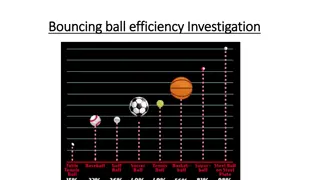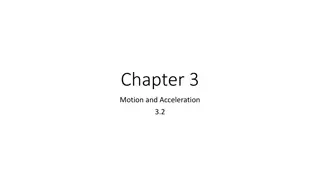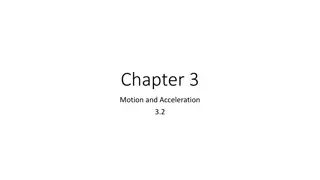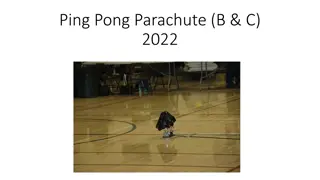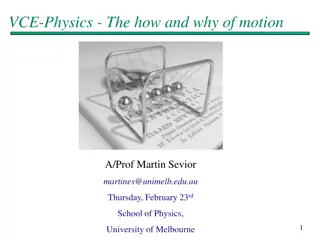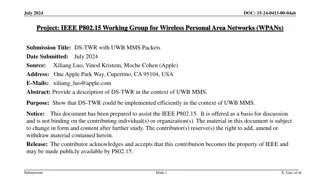Exploring Free Fall Motion of a Bouncing Ping-Pong Ball
Delve into the fascinating world of free fall motion by observing and analyzing the behavior of a bouncing ping-pong ball. The objective is to calculate free fall acceleration and showcase Newton's 2nd Law in action. Through engaging activities and theoretical discussions, students will gain insights into the dynamics of falling objects and how they interact with gravity and other forces. Theoretical concepts, experimental findings, and practical applications combine to enhance understanding of linear motion and acceleration in a fun and interactive manner.
Download Presentation

Please find below an Image/Link to download the presentation.
The content on the website is provided AS IS for your information and personal use only. It may not be sold, licensed, or shared on other websites without obtaining consent from the author. Download presentation by click this link. If you encounter any issues during the download, it is possible that the publisher has removed the file from their server.
E N D
Presentation Transcript
Free fall Observing and analyzing the free fall motion of a bouncing ping-pongball
Free fall Observing and analyzing the free fall motion of a bouncing ping-pong ball Objective The purpose of this activity is to calculate free fall acceleration, proving Newton s 2nd Law.
Free fall Observing and analyzing the free fall motion of a bouncing ping-pong ball Introduction and theory The aim of the introduction is to focus students on the lesson subject by refreshing acquired knowledge and asking questions which encourage research development. Key concepts from the theoretical framework, applied by the students during the lesson, are taught. Introduction Have you ever wondered why you don t fly into space when you jump? It sounds like an absurd question, but it makes us realize that something keeps us on the ground and doesn t let us escape. We see the same phenomenon when a table tennis or basketball bounces - they always reach a certain height and then fall back to the ground. Suppose you jump as high as you can. How would you describe the feeling during each moment of the jump, i.e. when you go up, when you reach the highest point and when you go down again? How do you think it feels (physiologically) when a person jumps out of an airplane? Explain.
Free fall Observing and analyzing the free fall motion of a bouncing ping-pong ball Introduction and theory Carry out the experiment activity with your class so that at the end you ll be able to answer the following question: How does the distance between an object and the ground vary when the object falls to the ground and bounces?
Free fall Observing and analyzing the free fall motion of a bouncing ping-pong ball Introduction and theory Theoretical Objects that fall to the ground from different heights move differently from objects that change location on a surface. The first case is a type of motion called free fall and is an example of linear motion with constant acceleration. On a theoretical basis, no real object on earth describes this kind of movement, because we consider free fall to happen when gravity is the only force acting on the object. In this case, it would be independent of shape or mass and would occur only in a vacuum where there is no friction force. On earth, air (or any other gas or fluid) exerts friction force on the object, changing the conditions of the fall. Yet over a short distance free fall activities, and this friction force has minimal effect.
Free fall Observing and analyzing the free fall motion of a bouncing ping-pong ball Introduction and theory The form of acceleration that occurs on objects in free fall is called acceleration of gravity (g). Its magnitude is approximately 9.8 m/s2 and is a consequence of the force of gravity that attracts the object towards the center of the earth. An acceleration of 9.8 m/s2 means that the object will increase its velocity by 9.8 m/s each second, as shown in the figure below.
Free fall Observing and analyzing the free fall motion of a bouncing ping-pong ball Introduction and theory The value of g will be positive for a body that moves toward the surface of earth, and negative as it moves away (e.g. on a vertical shot). The distance covered by an object in free fall is equal to the height (h). The formulas below represent the relationship between quantities involved in free fall: Initial velocity (Vi), final velocity (Vf), acceleration of gravity (g), height (h) and time (t).
Free fall Observing and analyzing the free fall motion of a bouncing ping-pong ball Introduction and theory Now students are encouraged to raise a hypothesis which must be tested with an experiment. Suppose having dropped a ping-pong ball you are able to measure the variation in the distance as it moves downwards in free fall from the initial point. What would you expect the variation in distance to be?
Free fall Observing and analyzing the free fall motion of a bouncing ping-pong ball Activity description Students will measure the variation in distance between a ping-pong ball dropped from a height of 1.5 m and the ground. They will analyze the data and calculate acceleration of gravity based on the empirical result to compare it with the information provided in the theoretical background.
Free fall Observing and analyzing the free fall motion of a bouncing ping-pong ball Resources and materials Labdisc USB communication cable Ping-pong ball
Free fall Observing and analyzing the free fall motion of a bouncing ping-pong ball Using the Labdisc a. Labdisc configuration To collect measurements with the Labdisc distance sensor, the Labdisc must be configured according to the following steps: Turn on the Labdisc by pressing If your computer supports Bluetooth communication we recommend you use wireless communication with the Labdisc. If your computer does not support Bluetooth you may use the USB cable for USB communication between the computer and the Labdisc. Please refer to the Quick Start Guide, supplied with the Labdisc, for instructions on how to establish Bluetooth communication and pair your device with the computer. Open the GlobiLab program.
Free fall Observing and analyzing the free fall motion of a bouncing ping-pong ball Using the Labdisc When using Bluetooth communication right click on the Bluetooth icon of the GlobiLab (in the lower right corner of the GlobiLab s screen) and select the Labdisc you are using. The icon will change from grey to blue indicating that the Labdisc and the computer are now connected via Bluetooth communication In order to use USB communication, connect the Labdisc and the computer using the USB cable supplied in the Labdisc box. Click on the USB icon (in the lower right corner of the software). This icon will turn blue, indicating that the Labdisc is connected to the computer via USB .
Free fall Observing and analyzing the free fall motion of a bouncing ping-pong ball Using the Labdisc Click on the button to configure the Labdisc. In the Logger setup window select only the distance sensor and select a rate of 25/sec for 1000 samples.
Free fall Observing and analyzing the free fall motion of a bouncing ping-pong ball Experiment The following steps explain how to perform the experiment: Once you have configured the Labdisc, place it 1.2 meters above the floor. Have the distance sensor facing the floor and start the data recording by pressing the Labdisc Select key . Drop a ping-pong ball from 80 cm. above the floor, directly below the distance sensor. The Labdisc should always remain at the same level above the floor. Observe the ball s height on the computer screen.
Free fall Observing and analyzing the free fall motion of a bouncing ping-pong ball Experiment After you receive a graph with more than three jumps, stop the data recording by pressing (you will see the instruction Press SCROLL key to STOP ), then press
Free fall Observing and analyzing the free fall motion of a bouncing ping-pong ball Results and analysis The following steps explain how to analyze the experiment results: Observe the graph displayed on the screen. Identify the section of the graph that represents the bounces of the ping-pong ball. Then, activate the markers , placing one at the start point and a second at the end point of the bounce section. Crop the samples to the right and the left of the markers - press on the message displayed on the screen. The graph will now contain only the selected section between the two markers. and click accept A right click on the distance legend to the right of the graph window will change the line graph to samples icons. Select the start and end point of one bounce button to obtain the equation of the parabola. and press the quadratic regression
Free fall Observing and analyzing the free fall motion of a bouncing ping-pong ball Results and analysis How do the results relate to your initial hypothesis? Did you find similarities between the equation provided by the software and the last equation in the theoretical background? What happens to the parabola amplitude during the experiment?
Free fall Observing and analyzing the free fall motion of a bouncing ping-pong ball Results and analysis The graph below should be similar to the one the students came up with.
Free fall Observing and analyzing the free fall motion of a bouncing ping-pong ball Conclusions Following are some questions and answers which should be developed by students in order to elaborate on their conclusions. According to the information provided in the theoretical background, what is the magnitude of initial velocity in free fall (in this case that of the ping-pong ball)? Students should point out that in free fall where an object is dropped from a given height (or distance), the initial velocity is 0. Using the equation from the graph and the equation for height in the theoretical background, students should calculate the value of the experimental acceleration of gravity. 2 Students should recognize that the expression1/2 gt from the height equation is equal to the first term of the quadratic regression obtained on the chart (e.g., 4.8 t ). We can establish these two expressions to be equal by following the equation: 2
Free fall Observing and analyzing the free fall motion of a bouncing ping-pong ball Conclusions Calculate the experimental error by comparing your empirical result with the theoretical value of g. Students should calculate the percentage difference of both values of g. For example, if we use the value obtained previously (g=9.6 [m/s ]), our percentage difference is 2.1%. 2 How would you explain the differences between the theoretical and empirical values of g? Students should establish that the friction force exerted by air on the ball may change the value of acceleration. In which section of the graph did you observe a positive value of g? Did you observe a negative value of g? Students should remember that acceleration of gravity is positive when the object approaches the surface of earth, and negative as it moves away from the ground. Therefore, g will be positive when the ball is moving downwards and negative when it is moving upwards.
Free fall Observing and analyzing the free fall motion of a bouncing ping-pong ball Conclusions Students should reach the following conclusions: If objects fall from a given height, they move with free fall motion. Free fall can be represented by a graph of distance as a function of time. If the object bounces, consecutive parabolas are created on the graph. We can obtain lots of information with the parabola equation and compare them to the mathematical expressions in the theoretical background. For example, we can calculate the experimental value of the acceleration of gravity. On the other hand, the acceleration of gravity value may be different from the theoretical one due to experimental errors. However, the most important factor to be considered is the friction force between air and the object.
Free fall Observing and analyzing the free fall motion of a bouncing ping-pong ball Activities for further application The aim of this section is that the students can extrapolate the acquired knowledge during this class through the application of it in different contexts and situations. Furthermore, it is intended that students wonder and present possible explanations to the experimentally observed phenomena. Further questions: What happens when someone jumps from a plane by parachute? Students should indicate that if someone opens a parachute during the fall, they expand the area surface in contact with the air. Therefore the system slows down because the friction force is dramatically increased, compared to the friction force exerted by the person without a parachute.
Free fall Observing and analyzing the free fall motion of a bouncing ping-pong ball Activities for further application Label the diagram indicating at what moment (A, B, C, D, E or F) the velocity of the ball is zero. Indicate where the ball velocity increased or decreased due to the g acceleration, in each of the sections (1, 2, 3, 4 and 5). Explain why. Students should explain that at points A, C and E the velocity of the ball is 0. At 1, 3 and 5 the velocity increases because of the g acceleration. In 2 and 4 the g acceleration slows down the ball velocity.
Free fall Observing and analyzing the free fall motion of a bouncing ping-pong ball Activities for further application A falling stone takes three seconds to reach the ground. From what height above the ground did the stone fall? Students should suppose that the initial velocity of the stone is zero. They should use the last equation of the theoretical background and solve the problem.




